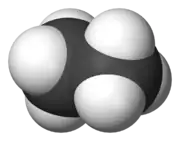Ethane
<< Methane | Propane thru decane >>
Ethane (/ˈɛθeɪn/ or /ˈiːθeɪn/) is a chemical compound, or hydrocarbon with a chemical formula of C2H6. At standard temperature and pressure, ethane is a colorless, odorless gas. Ethane is isolated on an industrial scale from natural gas, and as a byproduct of petroleum refining. Its chief use is as petrochemical feedstock for ethylene production. It could be described as two methane molecules attached to each other, less two hydrogens.

Number of hydrogens to carbons
This equation describes the relationship between the number of hydrogen and carbon atoms in alkanes:
- H = 2C + 2
where "C" and "H" are used to represent the number of carbon and hydrogen atoms present in one molecule. If C = 2, then H = 6.
Many textbooks put this in the following format:
- CNH2N+2
where "CN" and "H2N+2" represent the number of carbon and hydrogen atoms present in one molecule. If CN = 3, then H2N+2 = 2(3) + 2 = 8. (For this formula look to the "N" for the number, the "C" and the "H" letters themselves do not change.)
<< Organic chemistry | << Alkanes | << Methane | Ethane | Propane thru decane >> | Introduction to reactions >>